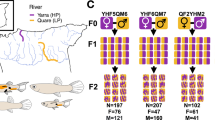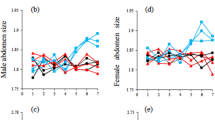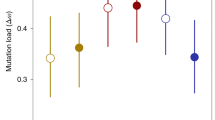Abstract
To understand the processes that maintain genetic diversity is a long-standing challenge in evolutionary biology, with implications for predicting disease resistance, response to environmental change, and population persistence1,2,3. Simple population genetic models are not sufficient to explain the high levels of genetic diversity sometimes observed in ecologically important traits2. In guppies (Poecilia reticulata), male colour pattern is both diverse and heritable, and is arguably one of the most extreme examples of morphological polymorphism known4,5. Negative frequency-dependent selection (NFDS), a form of selection in which genotypes are favoured when they are rare6, can potentially maintain such extensive polymorphism, but few experimental studies have confirmed its operation in nature7,8. Here we use highly replicated experimental manipulations of natural populations to show that males with rare colour patterns have higher reproductive fitness, demonstrating NFDS mediated by sexual selection. Rare males acquired more mates and sired more offspring compared to common males and, as previously reported, had higher rates of survival8. Orange colour, implicated in other studies of sexual selection in guppies, did predict male reproductive success, but only in one of three populations. These data support the hypothesis that NFDS maintains diversity in the colour patterns of male guppies through two selective agents, mates and predators. Similar field-based manipulations of genotype frequencies could provide a powerful approach to reveal the underlying ecological and behavioural mechanisms that maintain genetic and phenotypic diversity.
This is a preview of subscription content, access via your institution
Access options
Subscribe to this journal
Receive 51 print issues and online access
$199.00 per year
only $3.90 per issue
Buy this article
- Purchase on Springer Link
- Instant access to full article PDF
Prices may be subject to local taxes which are calculated during checkout


Similar content being viewed by others
References
Lewontin, R. C. The Genetic Basis of Evolutionary Change (Columbia Univ. Press, 1974)
Turelli, M. & Barton, N. H. Polygenic variation maintained by balancing selection: pleiotropy, sex-dependent allelic effects and G×E interactions. Genetics 166, 1053–1079 (2004)
Mitchell-Olds, T. Willis, J. H. & Goldstein, D. B. Which evolutionary processes influence natural genetic variation for phenotypic traits? Nature Rev. Genet. 8, 845–856 (2007)
Houde, A. E. Sex, Color and Mate Choice in Guppies (Princeton Univ. Press, 1997)
Brooks, R. & Endler, J. A. Direct and indirect sexual selection and quantitative genetics of male traits in guppies (Poecilia reticulata). Evolution 55, 1002–1015 (2001)
Ayala, F. J. & Campbell, C. A. Frequency-dependent selection. Annu. Rev. Ecol. Syst. 5, 115–138 (1974)
Bleay, C. Comendant, T. & Sinervo, B. An experimental test of frequency-dependent selection on male mating strategy in the field. Proc. R. Soc. B 274, 2019–2025 (2007)
Olendorf, R. et al. Frequency-dependent survival in natural guppy populations. Nature 441, 633–636 (2006)
Hughes, K. A., Rodd, F. H. & Reznick, D. N. Genetic and environmental effects on secondary sex traits in guppies (Poecilia reticulata). J. Evol. Biol. 18, 35–45 (2005)
Hughes, K. A., Du, L., Rodd, F. H. & Reznick, D. N. Familiarity leads to female mate preference for novel males in the guppy, Poecilia reticulata. Anim. Behav. 58, 907–916 (1999)
Zajitschek, S. R. K. & Brooks, R. C. Distinguishing the effects of familiarity, relatedness, and color pattern rarity on attractiveness and measuring their effects on sexual selection in guppies (Poecilia reticulata). Am. Nat. 172, 843–854 (2008)
Hampton, K. J., Hughes, K. A. & Houde, A. E. The allure of the distinctive: reduced sexual responsiveness of female guppies to ‘redundant’ male colour patterns. Ethology 115, 475–481 (2009)
Maynard Smith, J. Evolution and the Theory of Games (Cambridge Univ. Press, 1982)
Olendorf, R., Reudi, B. & Hughes, K. A. Primers for 12 polymorphic microsatellite DNA loci from the guppy (Poecilia reticulata). Mol. Ecol. Notes 4, 668–671 (2004)
Johnson, A. M. et al. Inbreeding depression and inbreeding avoidance in a natural population of guppies (Poecilia reticulata). Ethology 116, 448–457 (2010)
Kalinowski, S. T., Taper, M. L. & Marshall, T. C. Revising how the computer program CERVUS accommodates genotyping error increases success in paternity assignment. Mol. Ecol. 16, 1099–1106 (2007)
Magurran, A. E. Evolutionary Ecology: The Trinidadian Guppy (Oxford Univ. Press, 2005)
Pires, M. N., Arendt, J. & Reznick, D. N. The evolution of placentas and superfetation in the fish genus Poecilia (Cyprinodontiformes: Poeciliidae: subgenera Micropoecilia and Acanthophacelus). Biol. J. Linn. Soc. 99, 784–796 (2010)
Evans, J. P., Zane, L., Francescato, S. & Pilastro, A. Directional postcopulatory sexual selection revealed by artificial insemination. Nature 421, 360–363 (2003)
Matthews, I. M. & Magurran, A. E. Evidence for sperm transfer during sneaky mating in wild Trinidadian guppies. J. Fish Biol. 56, 1381–1386 (2000)
Evans, J. P., Pilastro, A. & Ramnarine, I. W. Sperm transfer through forced matings and its evolutionary implications in natural guppy (Poecilia reticulata) populations. Biol. J. Linn. Soc. 78, 605–612 (2003)
Rosenthal, H. L. Observations on reproduction of the poeciliid Lebistes reticulatus (Peters). Biol. Bull. 102, 30–38 (1952)
Petit, C. & Ehrman, L. in Evolutionary Biology Vol. 3 (eds Dobzansky T., Hecht M. K. & Steere W. C. ) Sexual Selection in Drosophila. (North-Holland, 1969)
Farr, J. A. Male rarity or novelty, female choice behavior and sexual selection in the guppy Poecilia reticulata Peters (Pices: Poeciliidae). Evolution 31, 162–168 (1977)
Shuster, S. M. & Wade, M. J. Equal mating success among male reproductive strategies in a marine isopod. Nature 350, 608–610 (1991)
Dijkstra, P. D., Seehausen, O. & Groothuis, T. G. G. Direct male–male competition can facilitate invasion of new colour types in Lake Victoria cichlids. Behav. Ecol. Sociobiol. 58, 136–143 (2005)
Takahashi, Y., Yoshimura, J., Morita, S. & Watanabe, M. Negative frequency-dependent selection in female color polymorphism of a damselfly. Evolution 64, 3620–3628 (2010)
Kokko, H., Jennions, M. D. & Houde, A. Evolution of frequency-dependent mate choice: keeping up with fashion trends. Proc. R. Soc. B 274, 1317–1324 (2007)
Gigord, L. D. B., Macnair, M. R. & Smithson, A. Negative frequency-dependent selection maintains a dramatic flower color polymorphism in the rewardless orchid Dactylorhiza sambucina (L.) Soó. Proc. Natl Acad. Sci. USA 98, 6253–6255 (2001)
Spurgin, L. G. & Richardson, D. S. How pathogens drive genetic diversity: MHC, mechanisms and misunderstandings. Proc. R. Soc. B 277, 979–988 (2010)
Reznick, D. N., Butler, M. J. IV., Rodd, F. H. & Ross, P. Life-history evolution in guppies (Poecilia reticulata): 6. Differential mortality as a mechanism for natural selection. Evolution 50, 1651–1660 (1996)
Schneider, C. A., Rasband, W. S. & Eliceiri, K. W. NIH Image to ImageJ: 25 years of image analysis. Nature Methods 9, 671–675 (2012)
SAS. Institute. SAS/STAT 9.3 User's Guide. (SAS Institute, 2011)
Endler, J. A. A predator's view of animal color patterns. Evol. Biol. 11, 319–364 (1978)
Acknowledgements
We thank R. Olendorf for help with field work and genotyping; D. Punzalan, K. Dixon, M. Bryant, T. Pitcher, C. Baril, A. Inman and C. Hurt for field work; C. Gibson, K. McGhee for photographs in Fig. 1 and for animal rearing; J. Koprivnikar for animal rearing; and A. Vanesyan for collecting morphology data. D. Reznick provided advice on field experiments, and D. Punzalan, K. Dixon and M. Fitzpatrick commented on manuscript drafts. In Trinidad, we thank the Sinanan family for accommodation, and I. Ramnarine and the government of Trinidad for permission to collect guppies and to work in the Quare watershed. This work was supported by grants from the National Science Foundation (to K.A.H. and A.E.H.) and the Natural Sciences and Engineering Research Council (NSERC) of Canada (to F.H.R.).
Author information
Authors and Affiliations
Contributions
K.A.H. and F.H.R conceived and designed the experiment and conducted all data analyses. A.E.H. consulted on experimental design and A.C.P reared live animals. All authors participated in field experiments and in writing the paper.
Corresponding author
Ethics declarations
Competing interests
The authors declare no competing financial interests.
Extended data figures and tables
Extended Data Figure 1 Population means for effects of rarity and morph on reproductive success.
Centre values are marginal means from generalized linear mixed models; bars indicate s.e.m. adjusted for model parameters. *P < 0.01 and **P < 0.05, respectively. a, Mates assigned to common (white bars) and rare (dark grey bars) males in all populations (All, n = 124 common, 42 rare) and by population (M, Mausica, n = 43 common, 17 rare; Q1, Quare 1, n = 53 common, 19 rare; Q7, Quare 7, n = 28 common, 6 rare). b, Offspring for common and rare males. c, Mates assigned to males with uncoloured (white bars) or coloured (dark grey bars) tails for all populations (All, n = 79 uncoloured, 87 coloured) and by population (M, Mausica, n = 26 uncoloured, 34 coloured; Q1, Quare 1, n = 35 uncoloured, 37 coloured; Q7, Quare 7, n = 18 uncoloured, 16 coloured). d, Offspring for males with uncoloured and coloured tails.
Supplementary information
Supplementary Table 1
The table contains the following data: Experimental males, classification, phenotypes, and assigned offspring and mates. (XLSX 81 kb)
Supplementary Table 2
This table contains the following data: Results of paternity analysis; number of loci scored for offspring, mother, and candidate father, number of mismatches, LOD (log odds ratio), delta scores, and Confidence category. Only offspring assigned to experimental 'rare' and 'common' males are listed. (XLSX 69 kb)
PowerPoint slides
Rights and permissions
About this article
Cite this article
Hughes, K., Houde, A., Price, A. et al. Mating advantage for rare males in wild guppy populations. Nature 503, 108–110 (2013). https://doi.org/10.1038/nature12717
Received:
Accepted:
Published:
Issue Date:
DOI: https://doi.org/10.1038/nature12717
This article is cited by
-
Temporal stability in color patterns and body size variation in a six-year monitored population of the aposematic toad (Melanophryniscus rubriventris)
Evolutionary Ecology (2023)
-
A large and diverse autosomal haplotype is associated with sex-linked colour polymorphism in the guppy
Nature Communications (2022)
-
Measuring frequency-dependent selection in culture
Nature Human Behaviour (2022)
-
An Evolutionary Perspective on Appearance Enhancement Behavior
Archives of Sexual Behavior (2022)
-
Correlational selection in the age of genomics
Nature Ecology & Evolution (2021)
Comments
By submitting a comment you agree to abide by our Terms and Community Guidelines. If you find something abusive or that does not comply with our terms or guidelines please flag it as inappropriate.



